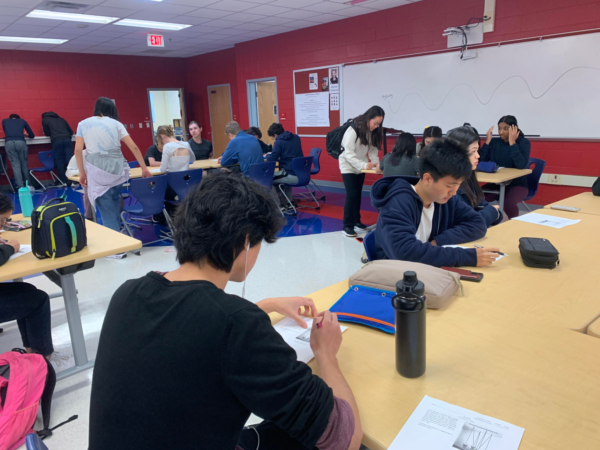AP Physics C: Mechanics and Electricity & Magnetism has the reputation of being one of the hardest Advanced Placement (AP) classes out there, let alone hardest at Jefferson. And with a hard AP class comes an even harder AP exam. Surprisingly, you only need about 60% to earn a five on the exam. But despite the low score you need to achieve a five, the majority of the test-takers fail.
“[For] the physics department at TJ, the way that we structure and the way that we grade actually very closely mirrors the way that the College Board and the way that a lot of university departments operate,” Optics Lab Director Mark Hannum said.
Like the College Board and the AP exam, physics tests at Jefferson aim to apply the principles learned into a totally new real world example. Consequently, many students fail to achieve what they think a good score is.
“[A] 70 is a good score, and we want to make sure that a good score translates to an A,” Hannum said.
This usually means that they will curve and give Student Learning Objectives (SLOBs). SLOBs, like many other things, are unique to Jefferson. Contrary to what people may think, SLOBs actually have two reasons for their name.
“Typically students are having this problem during lunch. So they’re making a mess and they’re being SLOBs. But it also stands for Student Learning Objectives, which is really just trying to get students to learn specific physics objectives,” Hannum said.
Hannum goes on to share the history behind SLOBs in greater detail.
“SLOBs are a very old tradition from TJ, started by Dr. Dell, who started teaching at TJ in the early 90s, maybe even the late 80s. So we’ve developed this little game that we call SLOBs, where every lunch once a week during lunch, the students come to the physics commons, and they are given a question and then they have all of lunchtime to finish the question,” Hannum said.

This staple of Jefferson has not worn off over the decades of its existence, with students flocking to Hopper Commons whenever a SLOB is in session.
“SLOBs are pretty fun and good practice for future tests. I think the difficulty right now is doable. Honestly I would say that the FBDs are the problem, and after that is just solving equations,” sophomore Devin Park says.
Students who took AP Physics last year may point out that although more SLOBs are welcome, the lack of test curves is concerning.
“Some of the newer FCPS policies that have minimums of 50 percent on things as well as our larger retake policy and test correction policy. That became the better way to kind of make up that gap between what is expected of students and then how that translates into the larger FCPS system,” Hannum said.
Although SLOBs have their own upsides, many people feel like curves are more helpful.
“SLOBs are a fun way to earn some extra points, but right now curves would definitely benefit my grade better, so I would prefer curves,” Devin Park said.
The running sentiment that seems to be going on is that test curves will usually offer around the same, if not more points without any additional effort. But it is important to note that although grades may seem like the most important thing currently, what really matters is the information that you retain years after learning.
“[I try] to set up a fun environment where people can practice physics and enjoy the feeling of getting a hard physics problem correct,” Hannum said.

![Blocking your way into the Hopper Commons is this sign that discourages other students from eating lunch here. Every Thursday, this sign makes sure that AP physics students have the ideal environment to focus on the SLOB. “[Last week’s] SLOB had a very high success rate, much higher than I actually thought,” Mark Hannum, the Optics Lab Director, said.](https://www.tjtoday.org/wp-content/uploads/2023/10/pasted-image-0-21-1200x900.png)